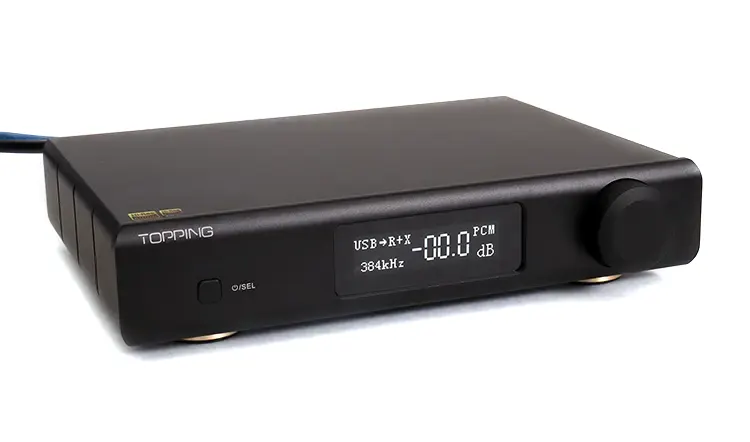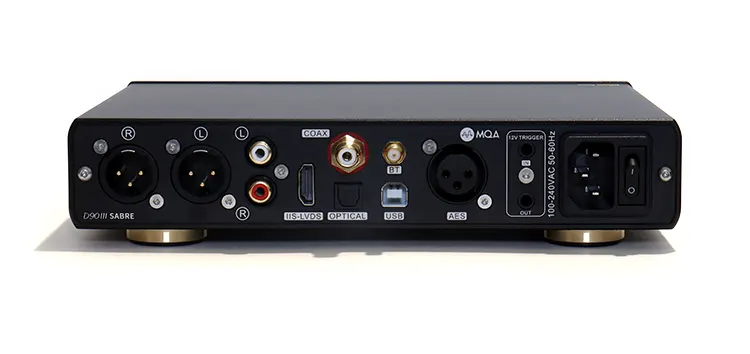Today, Louis reviews the Topping D90 III Sabre, which is a new high-end dual ES9039SPRO and Bluetooth 5.1 equipped balanced desktop DAC. It is priced at $899.
Disclaimer: This sample unit was sent to me in exchange for my honest opinion. Headfonics is an independent website with no affiliate links or status. We thank the team at Topping for giving us their support.
Click here to read more about Topping products that we have previously assessed on Headfonics.
Note that this article follows our current scoring guidelines which you can read in more detail here.
Today, I will be assessing Topping’s third version of their very popular D90 desktop standalone DAC, the Topping D90 III Sabre which is priced at $899 SRP.
I will share my overall day-to-day experience with one on hand and most importantly, its audible performance when hooked up to several headphone amplifiers.
The Topping D90 III Sabre comes in two color schemes, black and silver so on purchase day It’s just a matter of matching the color scheme of your A90 or discrete amplifier model since the A90 was designed to pair up perfectly with the D90 III Sabre DAC but not exclusively so.

Tech Highlights
First off, let’s quickly go through the previous D90 DAC’s version revision list. The first D90 counted on the AKM AK4499 chip on DAC duty and the second version moved over to the ESS ES9038PRO chip to handle the DAC’s section of the unit. Version two is still available at the moment by the way.
This time around, the Topping D90 III Sabre uses a dual ESS ES9039SPRO setup. I did some probing around and found that the ES9039PRO has some of the best overall scores as far as signal-to-noise ratio and a couple of other specs from previous ESS releases.
The D90 III Sabre is, in fact, one of the best-measuring DACs around and is certainly Topping’s best up-to-date when it comes to specifications and sheer performance numbers.
There’s also an Altium Altera Max II CPLD being used as a jitter eliminator that maintains jitter at -160db regardless of what input you tap into.
Topping also incorporated a new I/V conversion circuit or a current-to-voltage converter that allowed Topping to lower that noise floor even further comparatively to previous models.
Decoding
The D90 III DAC is capable of reaching 32BIT/768kHz for PCM via USB and the ISS inputs. Optical, SPDIF, and AES inputs drop down to 192k. Add to that native DSD at up to DSD512 to complete the list of compatible lossless formats playable on the D90.
The Topping D90 III Sabre DAC can also stream MQA services as well as being compatible with the MQA Studio file format. So, if you’re into MQA and desire a stable and capable MQA platform then this is a good DAC to get.
Bluetooth
The D90 III Sabre can handle LDAC along with all the other Bluetooth codecs including aptX down to AAC and SBC. No sign of aptX Lossless yet but it’s early stages for this new codec in most modern gadget rollouts.
The reception is handled by an SMA-type antenna mounted in the rear panel that seems to do a good job at receiving, but it just receives and does not transmit a BT signal.
The antenna is also used to pick up signals from the Bluetooth remote control which allowed Topping to omit the visible front-mounted IR pickup.
Design
The D90 III Sabre cabinetry seems to be metal front to back, probably aluminum. The cabinet doesn’t have any sharp edges anywhere and the corners are rounded and smooth.
The overall design is minimalistic upfront but busy in the rear. There’s a sole button and a volume kob upfront plus the digital display which sits in the center. The back is covered in IO ports, the power receptacle, and the main power switch.
The volume knob has a press-to-activate feature and has indents as you make adjustments. It’s not a motorized volume control but most times you’re just going to set it at 0 decibels and forget it as I did.
It’s a sturdy little box and most times it’s cool to the touch and only long hours of use will produce a slight amount of warmth within the cabinet.
However, I did notice that there was no ventilation but thankfully it wasn’t needed if the unit keeps running at the low temperatures it does.
I/O
The Topping D90 III Sabre IO consists of a two-way output and an assortment of digital inputs. The two outputs are a set of three-pin XLR male connectors plus a set of RCA connectors. This set of output taps can be selected to work simultaneously or individually within the system menu.
You also can adjust the voltage output levels of each set. For example, you can set the XLR to output either 4 volts or 5 volts. The same with the RCA set which can output a selectable 2 volts or 2.5 volts.
The four sets of inputs are also selectable with the selector button up front. There’s a USB type B, an optical port, an SPDIF connection, and an AES port along with an IIS-LDVS advanced port to facilitate audio data control at the circuitry level.
Another set of 3.5mm 12-volt trigger ports allows you to daisy chain any number of compatible 12v trigger-equipped units and have one unit power on and off the array simultaneously.
The D90 III Sabre also has preamplifier features that let you use the unit as such. There’s also a fixed or variable volume feature within the system menu to increase the preamp functionality and give you on-board volume control.
Controls
There’s not much to talk about here. The volume control and the select button perform a few functions individually. The button is a multifunction type and so is the volume control. The volume knob implementation beats the previous D90’s pushbutton volume control implementation I must say.
The volume control has a push-to-activate feature that is used to put the D90 III Sabre into Bluetooth pairing mode. There is also a feature within the system menu that allows you to adjust volume increments down to low 0.5-decibel increase intervals and up to 2.0 decibels.
The single button up front can be used to turn the unit on and wake it from standby mode once the rear power button is engaged in the on position.
The other function it offers is access to the system menu in conjunction with the rear-mounted power button and the volume knob. It also selects the input source.
System Menu
There’s a lot to do within the Topping D90 III Sabre’s system menu starting with auto power off and screen brightness settings. But there are also some complex settings, particularly for the IIS interface.
The menu also includes many sound shaping tools like a PCM seven filter selector, line out voltage selector, polarity and channel balance plus a volume decibel step setting.
However, the one I found the most intriguing was the sound mode setting which includes three presets named, off, valve sound, and transistor sound.
I’m not going to touch on the intricacies of these sound profiles because that would entail a large section explaining the synergy aspects and would take a lifetime to explain. That aspect I leave it up to you to explore if you do obtain this model.
There’s lots to do as stated but you can’t access the menu on the fly from the front panel and therefore you can’t make adjustments while the unit is in use. You have to flip the rear-mounted power button while pressing the front-mounted select button to access the menu or use the remote control.
Another small insight I can add is that the screen itself is not flagship material and they should have gone with one of their newer color displays. So there are two particular implementations I would have changed. But these are the limits of my complaints overall.
Packaging & Accessories
The D90 III Sabre included accessories list is a short one. There’s a power cord, a Bluetooth antenna, a remote control, a 3-foot USB cable, and some literature.
The box is rather large compared to the main unit. That has a pro and a con because it means there’s plenty of room for the unit to sit comfortably inside the box, wrapped in foam, by the way.
It would have been nice to receive some connectivity options, perhaps a set of RCA and a set of XLR cables inside the box. Most of us have plenty of cables on hand but unfortunately, those who don’t must outsource some.
Sound Impressions
Listening sessions were mostly done using the Topping stack consisting of the D90 III Sabre paired with the A90 amplifier. Custom XLR cables were used and a 5-volt output was selected. The sound mode was set to the off position.
Various headphones were used like the HIFIMAN Arya Organic, the Ananda Nano, the Meze Audio Classics 99, and some IEMs including the FiiO FX15 and the HIFIMAN Svanar.
Timbre
The Topping D90 III Sabre is a DAC with a sound signature worthy of an audiophile’s approval that supplies the listener with a linear frequency response but also supplies a fast-acting general characteristic and a speedy delivery of the source.
It portrays a super clean translation that comes through fluidly and crystalline. The overall sonic representation is a cool, lively, and highly detailed one, with a silent background and a quick-acting transient response.
The bass response does come through quite lean, however. There’s ample bass but some might find it to lack weight unless you boost some of the lower frequencies. It’s a fast-paced, analytical bass but the rest of the frequency response curve seems to be well-balanced and natural in tonality.
This DAC produces a high level of resolution and it produces sharp, defined elements alongside a natural overall tonal character that will complement any amplifier and headphone you might have.
Staging and Dynamics
The staging capability of the Topping D90 III Sabre is excellent, especially when it comes to frontal staging projection and layering capabilities. There’s depth for days and layering is one of the A90 III Sabre’s strong points.
The aura around each element within recordings is well-defined and sharply painted. The dynamic range this DAC is capable of is also up there with some of the best I’ve heard as well and the numbers speak for themselves.
In direct comparisons with other DACs, the transient response and accurate timbre are some of the other strong points that can be mentioned. There seems to be very little to no veil which is how a DAC should behave and perform.
Click on page 2 below for my recommended pairings and selected comparisons.








